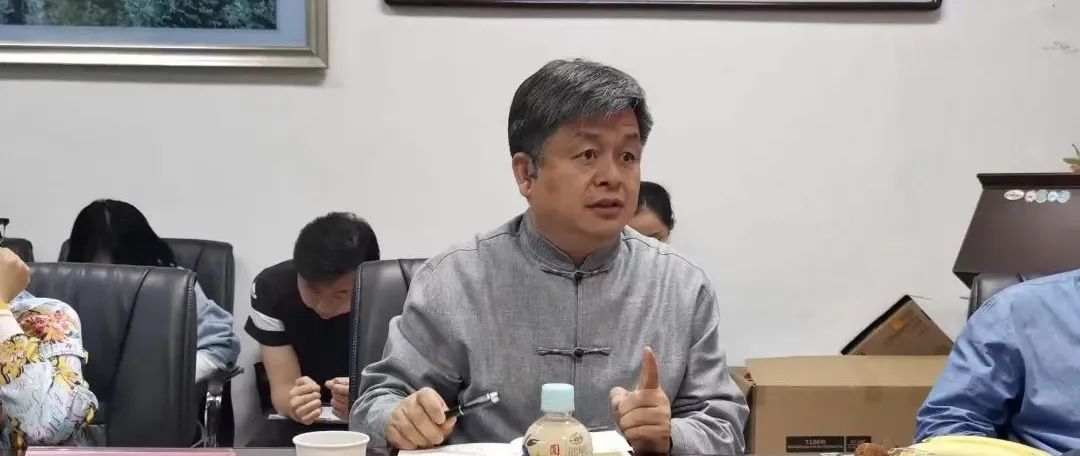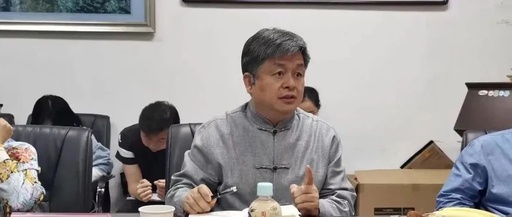Click Heart Medicine Xiao Langzhong↑ Accompanying You to Grow TogetherAuthor|Jia Dailin (WeChat ID: tcmjdl) Source|Heart Medicine Xiao Langzhong (WeChat Official Account)Record of the “Kengqiang TCM Exchange” Salon on March 16, 2022

【Abstract】
This article is an excerpt from the sharing session of Teacher Jia Haizhong during the “Kengqiang TCM Exchange” audio recording on March 16, 2022. The sharing mainly includes Teacher Jia’s insights on the relationship between the throat and the physiology and pathology of the five internal organs, as well as how to treat throat diseases and the connection between throat diseases and internal injury syndromes.

Image from previous on-site exchange
Audio sharing by Teacher Jia Haizhong
Hello everyone, thank you, Teacher Zhao. I find that our salon is getting better and better. Today, I have a clear feeling that we have pushed the academic discussion of “Kengqiang TCM Exchange” to a new height, which is related to this topic.
Because the throat is a crucial gateway in our body, if the throat is ill, it is essentially a “choking disease,” which can lead to many problems. In clinical practice, as the teachers have just explained from their experiences, like Teacher Sanhu’s discussion on Sheng Ma (Bupleurum), I completely agree. It has been about eight or nine months since I treated a patient with lower throat cancer. Initially, he was advised to undergo surgery, but he firmly refused surgery and chemotherapy, opting instead for traditional Chinese medicine. I told him that treating lower throat cancer purely with traditional Chinese medicine was my only case. This case involved using Sheng Ma (Bupleurum), Bie Jia (Tortoise Shell), Ma Huang (Ephedra), and Dang Gui (Angelica), among others, with 60 grams of Sheng Ma. This patient has been stable for over eight months and overall is doing quite well. Therefore, I believe that traditional Chinese medicine, by utilizing classical methods, can indeed demonstrate its power.
At the same time, there was another patient with lower throat cancer who underwent surgery and received chemotherapy and radiotherapy, but his condition worsened. After coming to us and using traditional Chinese medicine, his condition gradually improved, giving him hope. However, he later experienced a relapse and was hospitalized due to bleeding. I even showed him a video, but after the New Year, I am unsure of his condition; I suspect he may have passed away. This indicates that the quality of life with traditional Chinese medicine is higher than with surgery, chemotherapy, and radiotherapy. Thus, I feel proud of traditional Chinese medicine; studying it is indeed something to be proud of.
Now, regarding the discussion on throat diseases, I believe we should not limit ourselves to just one disease. We need a systematic understanding of throat diseases. I would like to share my thoughts on this from five aspects regarding my approach to diagnosing and treating diseases.
【Heart and Throat】
First, we need to consider the relationship between the heart and the throat. As Teacher Zhao Yong mentioned, only by truly addressing cardiovascular issues can one understand the relationship between throat infectious diseases and cardiovascular diseases, including heart and vascular diseases. In my clinical practice, I often encounter cases where throat infections lead to myocarditis, exacerbating coronary heart disease and causing arrhythmias, which are frequently seen, especially arrhythmias that are indeed related to the throat, though not all cases are.
In Zhang Zhongjing’s “Jin Kui Yao Lue,” the condition of Ben Tun (running piglet disease) is described, where qi rises and obstructs the throat, often leading to paroxysmal arrhythmias. The treatment for these conditions includes Ben Tun Decoction, which prominently features Ge Gen (Kudzu), which is also an excellent and important herb for treating throat pain and is very effective for myocardial damage caused by infections and arrhythmias due to microcirculation disorders. This is a medicine that has consistently proven to have significant effects. Therefore, in the future, when we encounter discomfort in the throat accompanied by paroxysmal sensations of obstruction without other symptoms, especially paroxysmal ones, we must consider that there may be a heart issue.
【Lung and Throat】
The second aspect is to consider the relationship between the throat and the lungs. The relationship between the lungs and the throat is something everyone should be quite familiar with; various lung diseases almost always arise from the throat through the trachea. Therefore, the entire respiratory system’s diseases are closely related to the throat, including the various pathogenic infections discussed earlier that affect the throat.
What has been discussed is quite comprehensive, but I would like to add a few more general observations. First, throat wind and throat cold can occur simultaneously. Throat wind often develops into lung issues, while throat cold is often related to digestive tract issues.
In Zhang Zhongjing’s formulas, there is a prescription that treats throat wind and cold, throat dryness, and bitter taste in the mouth, which is Xiao Chai Hu Decoction. This basic formula is very effective for acute throat wind and cold. After throat diseases occur, there may be abnormal taste sensations, such as a bitter mouth and other taste abnormalities. Xiao Chai Hu Decoction is a fundamental formula for this.
Formulas like Yin Qiao San, Sheng Jiang San, Pu Ji Xiao Du Yin, and Xian Fang Huo Ming Yin are used to treat purulent throat diseases. For dampness and heat, Gan Lu Xiao Du Yin can be used, while for cold pathogens, as mentioned by Teacher Yu, Ma Xin Fu Zi Decoction, Ban Xia San, and Decoction are also very effective. For heat pathogens, Yin Qiao San, Jie Geng Gan Cao Decoction, Sheng Jiang San, and the previously mentioned Xian Fang Huo Ming Yin, Pu Ji Xiao Du Yin are all very effective. I believe it is essential to differentiate the nature of the pathogenic factors. Additionally, as Teacher Sanhu mentioned, Ma Huang Sheng Ma Decoction and Sheng Ma Bie Jia Decoction are also good options to consider.
【Stomach and Throat】
Another aspect to consider regarding throat diseases is their direct connection to the stomach, so they are closely related to esophageal and gastric diseases, and various gastrointestinal disorders may accompany throat abnormalities. For instance, in cases of pharyngitis, we say that the patient has throat discomfort, with symptoms such as burning sensation in the throat, throat itchiness, cough, and acid reflux, which are all closely related to the gastrointestinal tract.
One is that throat diseases can lead to gastrointestinal disorders, and the other is that gastric diseases, due to their descending function being obstructed, can lead to reflux esophagitis, which can further result in pharyngitis and throat diseases, or even lead to throat issues due to reflux. The treatment for these diseases should primarily focus on treating the stomach. Once the stomach is treated, the throat issues caused by reflux will improve.
In Zhang Zhongjing’s representative formulas, Ban Xia Hou Po Decoction is particularly effective for cold symptoms. Ban Xia Hou Po Decoction is the best formula for treating throat, esophageal, and gastric diseases. When the stomach’s descending function is smooth, it will not reflux, and the irritation to the throat will lessen, alleviating the sensation of throat swelling, which is the feeling of a lump in the throat. Upon examination of the posterior pharyngeal wall, there may be hyperplasia of lymphoid follicles, some large and some small, with larger ones resembling a lump stuck there. This illustrates the relationship between the throat and the stomach.
【Throat and Surrounding Areas】
The fourth aspect to consider is the relationship between the throat and its surrounding areas, referring to the soft tissue and nerve changes around the throat. Inflammation of the throat can spread to the surrounding tissues, leading to neck stiffness, neck pain, and a crackling sound when turning the neck. This is often due to throat inflammation combined with surrounding soft tissue changes. It is not cervical spondylosis, but it presents similarly, which is one of the spasm syndromes described in traditional Chinese medicine. For this type of condition, Ge Gen (Kudzu) is heavily used, and Ge Gen Decoction is an excellent choice. Of course, the other formulas mentioned earlier for treating primary throat diseases are also very good.
Within the spasm syndrome, there is also a condition called tic disorder, and in severe cases, it can lead to encephalitis caused by throat invasion, affecting the local nerves and resulting in tic disorders and Tourette syndrome. For these conditions, the primary treatment is based on Ge Gen Decoction, with modifications that can include Sheng Jiang San, and many other herbs can be adjusted.
【Brain and Throat】
The fifth aspect is to consider the relationship between the brain and the throat. In addition to what I mentioned earlier about the relationship between the throat and surrounding areas extending to the brain, there can also be issues due to mental disorders or vascular changes in the brain, leading to a loss or reduction in the nerve and muscle control of the throat, resulting in choking, difficulty swallowing, snoring, etc. Additionally, brain tumors can also cause these symptoms. In summary, when we think about throat diseases, we should first consider these five aspects, which will give us a systematic understanding of throat diseases.
【Causes of Throat Diseases】
This only relates to the internal organs; regarding the causes, in addition to what I mentioned earlier, we mainly need to consider a few factors. One is external pathogens, which I have already mentioned. Another is that the throat, as part of the body’s organs, must coordinate with the five internal organs to maintain health, so abnormal functions of other organs are often an internal mechanism for throat diseases. It is not just external pathogens; it is one of the internal mechanisms.
For example, long-term issues with the spleen and stomach can lead to malnutrition, which naturally decreases the throat’s resistance. For this type of condition, when there are both spleen and stomach deficiency and signs of heat in the throat, Bu Pi Wei Xie Yin Huo Sheng Yang Decoction is the first choice. The Bu Zhong Yi Qi Decoction mentioned earlier is also acceptable; the principles are essentially the same.
Additionally, in cases where the condition is extremely stubborn and tonifying the spleen and stomach is still ineffective, we need to consider that the disease has involved the essence and qi. At this point, we should use tonifying kidney methods. If it is deficient yang, we can use Shen Qi Wan with modifications; if it is deficient yin, we can use Mai Wei Di Huang and Liu Wei Di Huang. If there is a significant fire element, we can also use Zhi Bai Di Huang. In summary, at this point, we must consider tonifying the kidneys, which is related to treatment.
We also need to consider the issue of blood vessels, as all the qi and blood from the five internal organs must reach the throat through the blood vessels. If there is blood stasis, it can lead to throat diseases even if the five internal organs are normal. In this case, we need to use medicines that invigorate blood circulation, often selecting Xue Fu Zhu Yu Decoction, Chi Shao, Dan Shen, Da Huang, Xuan Shen. As mentioned by two teachers earlier, Hui Yan Zhu Yu Decoction primarily involves Xuan Shen. Therefore, using Xue Fu Zhu Yu Decoction in this way essentially considers the blood vessel issues leading to throat diseases.
【Non-Pharmacological Treatment of Throat Diseases】
Now, let’s discuss non-pharmacological treatments, which are an effective and rapid approach in traditional Chinese medicine for treating throat diseases, often faster than taking medicine. Acupuncture, especially pricking and bloodletting, is effective for treating throat pain and purulent tonsillitis, as many teachers have mentioned earlier. Based on our routine experience in treating these diseases, the acupuncture points we generally use are as follows: for the upper throat area, we select the Yifeng Point, located behind the earlobe; for the throat area, we select Tian Rong Point; for the oral pharyngeal area, we generally choose the acupuncture points between these two, which I have named Tian Yi Point, located right in the middle of Tian Rong and Yifeng points. For the lower throat area, we can also select the Tian Tu Point.
Some teachers have also mentioned that the efficacy is quite good. The previously mentioned Shaoshang Point, Shangyang Point, pricking and bloodletting, including Lieque, etc., actually indicate that almost all acupuncture points in the upper limbs and neck are effective for throat diseases.
【Prevention】
Due to time constraints, I won’t elaborate too much on other aspects. I believe I have covered the core content. Finally, I would like to mention the prevention of throat diseases. First, fresh air is the most important. For instance, throat diseases are more common on hazy days, and smokers tend to have more throat diseases. Therefore, it is essential to maintain fresh air. How to maintain it? If the environment is poor, wear a mask, but there is a problem with masks: the disinfectants inside can irritate the throat. So, when wearing such masks, be sure to shake the mask a few dozen times, then blow air through the mask with your mouth to expel any residual chemical disinfectants, preventing them from irritating the throat. I suspect many doctors have experienced this recently, especially after wearing masks for extended periods, throat discomfort can worsen.
Additionally, avoid eating spicy foods, as consuming chili and similar foods can easily trigger throat diseases. I just wanted to add this point. Originally, I also wanted to discuss throat diseases mentioned in the “Shang Han Za Bing Lun,” but as many points have already been gradually mentioned, I will not elaborate further. That’s all I want to say.
“Kengqiang TCM Academic Salon” Introduction:
Supported by relevant departments of Beijing University of Chinese Medicine and Dongzhimen Hospital, the “Kengqiang TCM Exchange” is a purely public welfare academic salon initiated by Professors Zhao Jinxie and Jia Haizhong. The term “Kengqiang” signifies a strong and resonant voice for traditional Chinese medicine, with an implication of academic debate and the rapid development of traditional Chinese medicine. The “Kengqiang TCM Exchange” is held monthly, with each session discussing important, hot, and misunderstood academic topics in traditional Chinese medicine. Through discussions among experts, some popular but incorrect viewpoints in traditional Chinese medicine are clarified, and in-depth discussions on various issues related to teaching, research, and clinical practice in traditional Chinese medicine are conducted. To ensure that the salon closely integrates with clinical efficacy, most participating experts are long-term practitioners in clinical settings. The original intention of the “Kengqiang TCM Exchange” is to cultivate excellent clinical talents in traditional Chinese medicine, with each discussion naturally revolving around the central theme of “improving clinical efficacy in traditional Chinese medicine.” After each “Kengqiang TCM Exchange” event, Zhao Jinxie arranges for graduate students to transcribe the recordings into written documents. The “Global Traditional Chinese Medicine” magazine has a special column to publish these discussion manuscripts. At the end of 2017, the “Kengqiang TCM Exchange” column in the “Global Traditional Chinese Medicine” magazine was selected as an excellent promotional work by the National Health and Family Planning Commission.
We welcome everyone to leave comments, share, and discuss together:)
– THE END –

